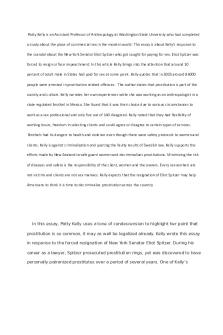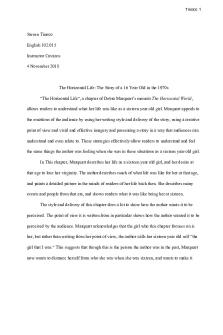Rhetorical Analysis Final PDF

| Title | Rhetorical Analysis Final |
|---|---|
| Author | Grace Layman |
| Course | English Composition 1 |
| Institution | Grand Canyon University |
| Pages | 5 |
| File Size | 67.8 KB |
| File Type | |
| Total Downloads | 77 |
| Total Views | 154 |
Summary
Rhetorical Analysis Essay for eng-105 about breakfast at tiffany's...
Description
1 Grace Layman ENG-105 October 13, 2019 Freauff Rhetorical Analysis of Oregon v. Kinkel “State of Oregon vs. Kipland Philip Kinkel” was written to defend the court’s decision of Kinkel’s sentencing in the original 1998 case. The defendant, Kinkel himself had said “Killers start sad and crazy” (Kinkel, 1998), so in hindsight it is understandable that mental illness was one of the biggest factors that decided his ruling during the 1998 trial. The court believed that Kinkel should have his sentence reduced under the plea that he was mentally ill. In this court document, Judge Haselton does an excellent job of defending the higher court’s decision through his use of ethos, pathos, and logos. In the document Judge Haselton references to three different audiences, doctors, lawyers, and judges, as well as the citizens of Oregon. The case was being appealed by The National Alliance for the Mentally Ill and The Alliance of the Mentally IllOregon. In 1998, Kipland Philip Kinkel was 15 years old and committed the crimes of 26 counts of attempted murder and four counts of aggravated murder during a school shooting at Thurston High School. The court decided he would serve 111 years and eight months, 25 years for each count of murder, concurrently. Judge Haselton was the presiding judge of the case in 1998. The appeal is based on the idea that the sentencing was cruel and unusual and broke the laws in Article I, section 15 and Article I, section 16 under the Oregon constitution.
2 The ethos used in the document shows Haselton used credible sources. A quote from the document’s states, “Dr. William Sack, a psychiatrist who examined defendant, concurred the defendant’s crimes were the product of a psychotic process that had been building over time” (Haselton, 2002, para. 11). This shows that he was checked out by a doctor and was diagnosed with this extreme psychotic breaking point. For lawyers to know this it allows them to be confident of their decisions since it came from a medical professional. They can look at this diagnosis and make it a point of why he should not be let out. If Kinkel was let out and the same build up happens then it is possible that he could cause harm to others again. Another way Haselton uses ethos is for the Oregon Community when he states, “The experts also agreed that there is no cure for paranoid schizophrenia” (Haselton, 2002, para. 9). This shows that medical professionals are not able to give him any kind permanent lasting solution for his diagnoses. Even with Kinkel’s best effort he will always suffer from schizophrenia. It is hopeless for him. There really is nothing Kinkel can do about it except take his medicine and even that will not cure him. The feeling of helplessness and overall doubt surrounding the rehabilitation of Kinkel is what allowed Hasleton to be able to place more weight on the protection of society rather than looking at all things equally, this in turn contributed to Kinkel’s sentence as well as the disagreement on sentencing duration. The pathos used in the document gives an insight of how everyone feels about the case. This is used by Haselton to invoke fear and sadness over the entire situation. He quotes a parent from the case saying, “And you have personally shown that you will lie to those whom most trust… and tell them you are fine and don’t require further treatment or medication... that even when free
3 medical care and rug treatment is available, that you will decide for yourself whether you take it or not” (Haselton, 2002, para. 14). This shows us that the people are scared for themselves, their families, and their community. The community does not want to live in fear, they want to send their child to school without the fear of Kinkel possibly repeating the crimes committed before. Kinkel’s return provokes fear for the entire community if he is let out. Another way Haselton shows pathos is, “They almost uniformly expressed intense fears of defendant being return to society and urged the defendant be incarcerated for the remainder of his life” (Haselton, 2002, para. 12). This shows that the entire community of Oregon is scared. They do not want to have to think about what will happen when he gets out. They do not want to be scared to send their kids to school. It again, justifies his sentence length. The judges and lawyers do not want the community to be scared so they went with a sentence that would not let Kinkel out. The logos used in this document shows the lawyers the facts on the case. It shows his logic about how the information throughout the case and how the ultimate decision of Kinkel’s sentencing was made. Some of this information is, “…for a total of 111 year and eight months. Because defendant’s sentences are mandatory minimum sentences under ORS 137.707…” (Haselton, 2002, para. 24). This clarifies that Haselton gave Kinkel the sparsest sentence possible. He did not dramatically increase the sentence date to keep him looked up but gave him the minimum that is required. This proves that the decision made by the court was not cruel and unusual but what was mandatory by the state constitution. In conclusion, Haselton proves his point that the courts made the right decisions through his use of ethos, pathos, and logos. He shows it clearly throughout the entire document through his word choice and citations used from the original case in 1998. The court of appeals should
4 agree with Haselton in keeping Kinkel locked up for the term of his sentence instead of letting him out sooner. This allowed for the continued peace of mind and feeling of safety to the residents of Oregon.
5 References Oregon Tax Court Opinion: (A155449) Kinkel v. Persson. (2016, June 10). Financial Law Reporter. Retrieved from https://link-galecom.lopes.idm.oclc.org/apps/doc/A566448357/ITOF? u=canyonuniv&sid=ITOF&xid=16a7df38 (n.d.). Retrieved from https://www.pbs.org/wgbh/pages/frontline/shows/kinkel/kip/writings.html....
Similar Free PDFs

Rhetorical Analysis Final
- 5 Pages

Final Rhetorical Analysis Essay
- 2 Pages

Rhetorical Analysis Final Draft
- 5 Pages

Rhetorical Analysis Final
- 5 Pages

Rhetorical Analysis
- 5 Pages

Rhetorical analysis
- 2 Pages

Puppy Rhetorical Analysis
- 4 Pages

Rhetorical analysis -1
- 4 Pages

Bowling Dana Rhetorical Analysis
- 4 Pages

Rhetorical Analysis Essay
- 5 Pages

Textual Rhetorical Analysis
- 3 Pages
Popular Institutions
- Tinajero National High School - Annex
- Politeknik Caltex Riau
- Yokohama City University
- SGT University
- University of Al-Qadisiyah
- Divine Word College of Vigan
- Techniek College Rotterdam
- Universidade de Santiago
- Universiti Teknologi MARA Cawangan Johor Kampus Pasir Gudang
- Poltekkes Kemenkes Yogyakarta
- Baguio City National High School
- Colegio san marcos
- preparatoria uno
- Centro de Bachillerato Tecnológico Industrial y de Servicios No. 107
- Dalian Maritime University
- Quang Trung Secondary School
- Colegio Tecnológico en Informática
- Corporación Regional de Educación Superior
- Grupo CEDVA
- Dar Al Uloom University
- Centro de Estudios Preuniversitarios de la Universidad Nacional de Ingeniería
- 上智大学
- Aakash International School, Nuna Majara
- San Felipe Neri Catholic School
- Kang Chiao International School - New Taipei City
- Misamis Occidental National High School
- Institución Educativa Escuela Normal Juan Ladrilleros
- Kolehiyo ng Pantukan
- Batanes State College
- Instituto Continental
- Sekolah Menengah Kejuruan Kesehatan Kaltara (Tarakan)
- Colegio de La Inmaculada Concepcion - Cebu




